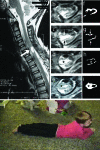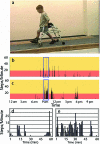Locomotor training restores walking in a nonambulatory child with chronic, severe, incomplete cervical spinal cord injury
- PMID: 18326054
- PMCID: PMC2390720
- DOI: 10.2522/ptj.20070315
Locomotor training restores walking in a nonambulatory child with chronic, severe, incomplete cervical spinal cord injury
Abstract
Background and purpose: Locomotor training (LT) enhances walking in adult experimental animals and humans with mild-to-moderate spinal cord injuries (SCIs). The animal literature suggests that the effects of LT may be greater on an immature nervous system than on a mature nervous system. The purpose of this study was to evaluate the effects of LT in a child with chronic, incomplete SCI.
Subject: The subject was a nonambulatory 4 1/2-year-old boy with an American Spinal Injury Association Impairment Scale (AIS) C Lower Extremity Motor Score (LEMS) of 4/50 who was deemed permanently wheelchair-dependent and was enrolled in an LT program 16 months after a severe cervical SCI.
Methods: A pretest-posttest design was used in the study. Over 16 weeks, the child received 76 LT sessions using both treadmill and over-ground settings in which graded sensory cues were provided. The outcome measures were ASIA Impairment Scale score, gait speed, walking independence, and number of steps.
Result: One month into LT, voluntary stepping began, and the child progressed from having no ability to use his legs to community ambulation with a rolling walker. By the end of LT, his walking independence score had increased from 0 to 13/20, despite no change in LEMS. The child's final self-selected gait speed was 0.29 m/s, with an average of 2,488 community-based steps per day and a maximum speed of 0.48 m/s. He then attended kindergarten using a walker full-time.
Discussion and conclusion: A simple, context-dependent stepping pattern sufficient for community ambulation was recovered in the absence of substantial voluntary isolated lower-extremity movement in a child with chronic, severe SCI. These novel data suggest that some children with severe, incomplete SCI may recover community ambulation after undergoing LT and that the LEMS cannot identify this subpopulation.
Figures




Comment in
-
Invited commentary.Phys Ther. 2008 May;88(5):590-1; author reply 594-5. doi: 10.2522/ptj.20070315.ic1. Phys Ther. 2008. PMID: 18450761 No abstract available.
-
Invited commentary.Phys Ther. 2008 May;88(5):592-4; author reply 594-5. doi: 10.2522/ptj.20070315.ic2. Phys Ther. 2008. PMID: 18450762 No abstract available.
References
-
- Barbeau H. Locomotor training in neurorehabilitation: emerging rehabilitation concepts. Neurorehabil Neural Repair. 2003;17:3–11. - PubMed
-
- Behrman AL, Lawless-Dixon AR, Davis SB, et al. Locomotor training progression and outcomes after incomplete spinal cord injury. Phys Ther. 2005;85:1356–1371. - PubMed
-
- Edgerton VR, Tillakaratne NJ, Bigbee AJ, et al. Plasticity of the spinal neural circuitry after injury. Annu Rev Neurosci. 2004;27:145–167. - PubMed
-
- Dietz V, Harkema SJ. Locomotor activity in spinal cord-injured persons. J Appl Physiol. 2004;96:1954–1960. - PubMed
-
- Behrman AL, Harkema SJ. Locomotor training after human spinal cord injury: a series of case studies. Phys Ther. 2000;80:688–700. - PubMed
Publication types
MeSH terms
Grants and funding
LinkOut - more resources
Full Text Sources
Medical

